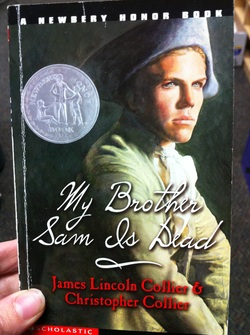
Collier, J. L. &. C. (1974). My brother sam is dead. New York: Scholastic.
Having Sam killed by his fellow soldiers is a great use of irony. The authors use irony to teach a lesson about what is expected from the reader. You cannot expect the characters to do what is normal.
Suspense is another great quality in this book. The authors keep you guessing about what will happen next. You love the characters and dislike them at the same time.
Exposition: Tim Meeker is excited about his brother Sam's return home to Conneticut until he realizes he has joined the Army.
Conflict: There are many minor conflicts throughout the story. The main conflict is Tim's choice between his family and the British or his brother Sam and the Army.
Rising Action: Sam returns. He excites Tim about the war. He takes guns from his family. Tim and his father set out and encounter some cowboys. Sam is arrested as a cattle thief.
Climax: Sam is sentenced to execution and Tim has to decide whether or not to help him escape.
Falling Action: Sam was executed.
Resolution: Tim reflects back on the events and realizes that war is not the answer.
*Challenged List
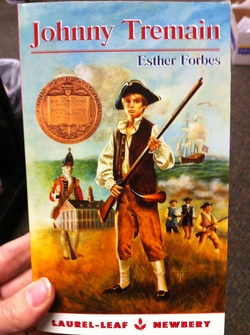
Forbes, E. (1943). Johnny tremain. New York: Bantam Doubleday Dell Publishing.
Johnny Tremain is a novel that uses foreshadowing throughout the book. There are many biblical references to pride and how you will fall. Tension is evident in the novel and the reader stays engaged.
It is a classic coming-of-age novel and I have always appreciated the value of this novel in the classroom.Forbes does a great job of reliving the historical facts in a novel that is interesting to read.
Exposition: Johnny Tremain is a young boy living in Boston during the American Revolution.
Conflict: Johnny is very confident and arrogant about his abilities as a blacksmith. Due to an error, Johnny must figure out how to live with his burnt hand.
Rising Action: Johnny gets a job delivering newspapers, he joins the effort of the Boston Tea Party and places himself in the middle of the events leading up to the battle of Lexington and Concord.
Climax: The Americans begin their war with the British.
Falling Action: Dr. Warren tells Johnny he can fix his hand.
Resolution: Johnny realizes that he is a patriot and he would continue to fight for freedom.
*Newbery Honor
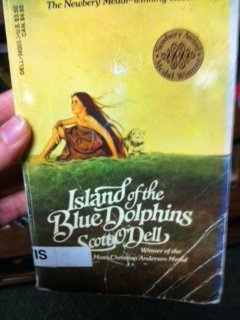
O'dell, S. (1978). Island of the blue dolphins. New York: Laurel Leaf.
The author keeps this novel full of suspense. Karana is always coming in contact with a natural force. Man vs. Nature is the type of conflict the author illustrates. Karana and the tidal waves, the animals, the environment.
Theme is important in this story. Scott O'Dell really tries to teach the reader the importance of survival in this book. I like that he chose a female as the protagonist and I feel girls can feel powerful after reading this.
Exposition:Karana, an Indian girl, lives alone on the Island of the Blue Dolphins.
Conflict: Karana needs to protect herself and learn how to survive.
Rising Action: Karana had trouble adjusting. She couldn't build a fire because of the rain. She didn't have a place to sleep.
Climax: Karana made weapons, she built a shelter and killed two wild dogs.
Falling Action: Karana has learned to take care of herself.
Resolution: Karana accepts her life and is confident in her ability to protect herself.
*Newbery Award
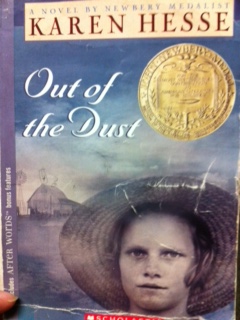
Hesse, K. (1999). Out of the dust. (1st ed.). New York: Scholastic.
Poetry! I love poetry and I especially love when authors can tell a complete story through poetry. The author uses so many devices to help connect the reader. The use of similes, metaphors and personification help the reader to understand events in the story.
Imagery is a very important quality in this book. Without her use of imagery, readers would not be able to really visual the landscape of Oklahoma during the Dust Bowl of the 1930's.
Exposition: Billie Jo lives on a farm in Oklahoma during hte Dust Bowl of the 1930's.
Conflict: Billie Jo tries to live and help on the farm while struggling with her inner self and need to leave the farm behind. Billie Jo also struggles with relationships in her family.
Rising Action: Billie Jo is a great pianist. She works hard at school and does what is expected of her. Her mother dies in an accident and Billie Jo's hands are ruined by attempting to help her mother.
Climax: Billie Jo runs away and tries to escape to California.
Falling Action: Billie Jo calls for her father to meet her at the train station because she realized that she needed to be home.
Resolution: Billie Jo accepts her father and his new wife. She realizes that she is a vital part of the farm and can't see her life without her father in it.
*Newbery Award
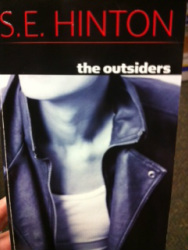
Hinton, S. E. (1967). The outsiders. New York: Penguin Group.
S.E Hinton develops characters that are fun to read about. While her characters are sterotypical, they do allow the reader to connect on some level.
Theme is an important literary quality. Readers learn about social class and in an age where money means everything to teenagers, this book allows the reader to search for deeper meaning. This book also is about loyalty and what lengths friends and family will go to protect one another.
Exposition: A town in Oklahoma during the 1960s. A family of orphans are learning to survive.
Conflict: The major conflict is between the two dominant social groups: The Greasers and the Socs. Ponyboy, the main character, also struggles with his identity and living with his brothers.
Rising Action: There are a series of actions leading up to the climax. Ponyboy and Johnny get jumped after leaving the movie theatre, they talk to Soc girls, and they end up stabbing Bob and killing him in defense. They escape to a church and accidently set it on fire. Johnny is injured in the fire.
Climax: The big Rumble between the Socs and Greasers. The Greasers win.
Falling Action: Johnny dies from his burns. Dally dies in a botched robbery attempt.
Resolution: Ponyboy realizes that "Nothing Gold Can Stay." He finally begins to write the essay for his English class.
*Challenged Book List
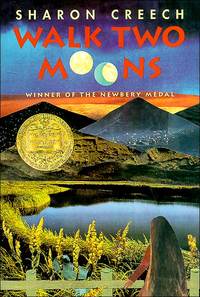
Creech, S. (1997). Walk two moons. HarperCollins.
Walk Two Moons is a great book to illustrate flashback. The author does a good job of keeping the reader entertained with many examples of the past to help the reader understand the development of the characters.
Creech also is a master at creating a story within a story. While you are learning about Sal and her family, you also get the story of Gram and Gramps, Phoebe and the Winterbottoms, The Finney's, and Ben.
Exposition: Sal is a young girl struggling with the disappearance of her mother.
Conflict: She agrees to go on a road trip with her grandparents to find her mom by her mother's birthday. Throughout her journey, she meets several people who have an impact on her life; her friend Phoebe and the Winterbottom family, Ms. Cadaver, and Ben.
Rising Action: A problem occurs when her grandmother becomes ill just a few miles from where her mother is located.
Conflict: Sal struggles with the decision to continue on her journey alone.
Falling Action: While at the site of her mother's death, a sheriff shows up and takes Sal back to her Grandpa where she learns her grandmother had passed away.
Resolution: Sal returns to Bybanks with the knowledge that she had known all along confirmed.
*Newberry Medal
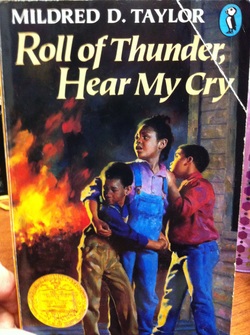
Taylor, D. M. (1976). Roll of thunder hear my cry. New York: Puffin Books.
Mildred Taylor does a great job of getting the reader to know Cassie. Cassie, the protagonist, learns so much about herself and her family through the course of this book. We feel her pain.
Taylor also does a great job of setting mood. The details are specific enough for a reader to identify with the characters and create emotions based on those feelings.
Plot Structure
Exposition: The four Logan children living in Mississippi in the 1930's.
Conflict: The conflict is in regards to the racial tensions in the South. Three men had been lynched by some white men.
Rising Action: Members of Cassie's (the protagonist) family rebel against the normal behaviors. TJ always manages to find himself in trouble.
Climax: TJ is caught stealing from the store. He runs to the Logan family for help.
Falling Action: A fire starts and everyone becomes concerned with the cotton fields.
Resolution: Cassie understands who started the fire and she cries for TJ.
*Challeged Book List
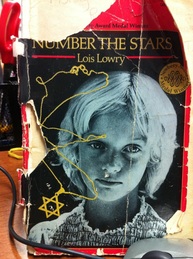
Lowery, L. (1989). Number the stars. New York: Dell Publishing.
The theme is this novel is crucial for readers to understand. The author expresses how courageous the young girls can be and also how friends stick together no matter what.
Accuracy is important in a historical fiction book. The author centers her story on real events in history and relates them to the reader in a believable way.
Exposition: A young girl living in Denmark during World War II. Her best friend Ellen is Jewish.
Conflict: Jewish families hiding from Nazi soldiers.
Rising Action: Familes are taken from their homes and being "relocated". Ellen, a neighbor girl, hides in Annemarie's family.
Climax: Annemarie must take a very important packet to her uncle. She encounters a soldier along the way.
Falling Action: Annemarie's uncle explains the purpose of the packet and how it was important to Ellen and her family.
Resolution: Annemarie awaits for the war to end so that she can return Ellen's necklace to her when she comes home.
*Newberry Medal

Konigsburg, E. L. (1967). From the mixed-up files of mrs. basil e. frankweiler. New York: Antheneum
I have always liked this book. The one in the picture is my personal copy. I enjoy the way Konigsburg tells the story. The author uses Mrs. Frankweiler's point of view to tell the story. She tells her lawyer which is unusual and adds more depth to the story.
The setting is fascinating. The author chose a well-known location, however if you are not familiar with the setting, the author does a great job of letting the reader become a part of it. I often find refuge in a library or museum, so I was able to connect to the author and the characters.
Exposition: Claudia decides to run away from home and takes her little brother with her. They escape to the Metropolitan Museum.
Conflict: Claudia and Jamie must try to stay out so sight and in hiding at the museum.
Rising Action: The kids decide to become a team and work their way through New York during the day and the museum at night.
Climax: While trying to work the mystery of the new exhibit, the kids go to Mrs. Basil E. Frankweiler's home.
Falling Action: Mrs. Frankweiler gives the kids access to the information they need.
Resolution: Mrs. Frankweiler takes the children home. Claudia and Jamie keep their secrets and agree to see Mrs. Frankweiler when they have enought money.
*Newberry Medal
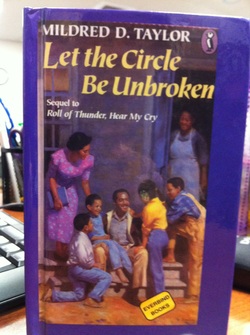
Taylor, M. D. (1981). Let the circle be unbroken. New York: Penguin Group.
Let the Circle Be Unbroken is the third book in Mildred Taylor's series. The author allows the reader to grow with the characters during this historical period. Readers learn about the effects of discrimination, predjudice and hate. Readers also learn about family, hard work and determination.
Exposition: 1930's at the Logan farm in the rural South.
Conflict: Cassie is not happy about her cousin Suzella coming to live with them. Farm life is still difficult to manage between the sharecrppers and landowners.
Rising Action: Mrs. Lee Annie stands up for her right to vote. Suzella helps get Cassie out of trouble at school.
Climax: Families protest at the courthouse about being forced off the land. A bottle is thrown and a riot enses.
Falling Action: The Sheriff breaks up the riot.
Resolution: The families all move on and let the circle be unbroken.
*Coretta Scott King Award










 RSS Feed
RSS Feed